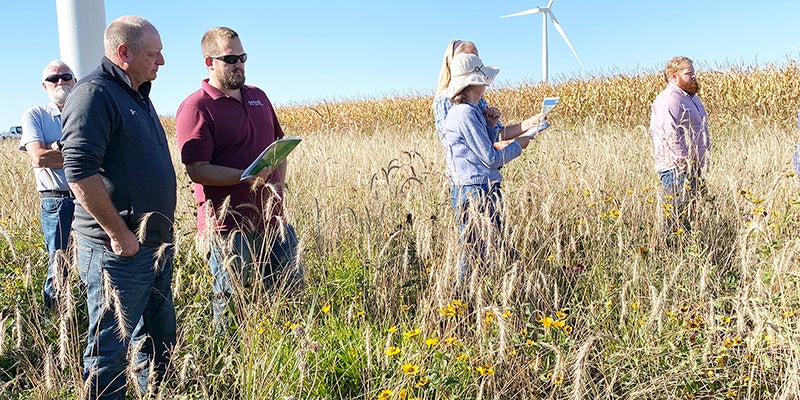Prairie strips new tool for farmers
Published 6:28 pm Tuesday, November 16, 2021

- James Fett, watershed technician for the Mower Soil & Water Conservation District leads people out looking at prairie strips. Photo provided
|
Getting your Trinity Audio player ready...
|
Mower SWCD, USDA-NRCS seek partners to enroll parts of cropland
After a big rain, Wayne DeWall would see soil from his Mower County cropland washing away in the headwaters of the Root River’s south branch.
In recent years, though, that has changed where DeWall has established sections of native vegetation called “prairie strips” in strategic spots of his cropland south of Grand Meadow. With those in place, he has seen a difference.
“Sometimes when you get a bigger rain event, you’ll have soil get trapped right in the edges of the prairie strip there,” DeWall said, “but that’s as far as it goes basically, which is exactly what we wanted and that’s good to see it actually working.”
Prairie strips are a way of conserving soil, improving water quality and providing habitat for wildlife and pollinators. Ranging from 30 to 120 feet in width, prairie strips are highly effective at reducing the loss of sediment, nutrients and pesticides when stormwater runs off cropland.
Farmers and landowners can sign up to establish prairie strips through the federal Conservation Reserve Program (CRP) under a 10- or 15-year conservation contract that keeps those acres from being used for cropland. CRP provides landowners with $258 to $300 per acre annually under the prairie-strip program, with most of the costs covered through cost-share assistance for preparing the site, purchasing seed, seeding the land and establishing the practice.
“This is the most-flexible set-aside land program in more than 30 years,” said James Fett, watershed technician for Mower Soil & Water Conservation District.
With this specific CRP program, farmers can drive equipment on the strips, which is not allowed in most other CRP programs.
Farmers enrolling in the program have used crop-yield records as a planning tool to place prairie strips in areas that make CRP more profitable than farming those acres, Fett said. Prairie strips are beneficial for landowners enrolling acres on their headlands, where machinery runs over soil the most.
“A lot of landowners are enrolling prairie strips in areas that are sensitive to erosion,” Fett said. “That’s often the headlands and fence lines of a field and along heavy tree cover where trees compete with corn and soybeans for sunlight, water and nutrients.”
More than 10 years of research has shown prairie strips can yield strong benefits for reducing excess amounts of sediment, nutrients and pesticides in stormwater runoff when integrated in small amounts into strategic spots within corn and soybean fields. Iowa State University research shows planting dense, diverse and deeply rooted strips of prairie next to corn and soybean fields has environmental benefits.
These small amounts of prairie come in the form of in-field, contour buffer strips and edge-of-field filter strips. Prairie strips provide strong benefits to a greater degree than other types of perennial vegetation because they incorporate a diverse array of native plant species with deep, multi-layered root systems and stiff stems that hold up during runoff from a driving rain.
Prairie mixes have a high density of flowers that promote pollinators and look colorful throughout spring, summer and fall.
DeWall has been pleased with what he has seen growing in his prairie strips.
“I’m very happy – we’ve got lots of native grasses, lots of flowers,” DeWall said. “It’s exactly what we were looking for when we started this. It took a few years to get to this point so you just have to be patient with it.”
DeWall’s prairie strip was implemented as part of the Minnesota Department of Agriculture’s Root River Field to Stream Partnership program, with partners closely monitoring and measuring each stormwater runoff event at the site. Prior to the prairie strip, the partnership gathered six years of data at the site.
Early results show immediate water-quality improvements due to the prairie strip at the DeWall farm. Fett collects stormwater-runoff samples from a monitoring site next to DeWall’s prairie strip as part of Field to Stream.
Iowa State’s STRIPS team has done research on prairie strips for more than a decade and found that integrating small amounts of prairie into strategic locations within corn and soybean fields – in-field contour buffer strips and edge-of-field filter strips – can yield significant benefits for soil, water and biodiversity.
Better benefits than perennial vegetation due to the diversity of native plant species incorporated with prairie strips, their deep and multilayered root systems and stiff-stems that hold up in a driving rain.
STRIPS also has found that prairie strips are one of the most-affordable and environmentally beneficial agricultural conservation practices available to farmers and landowners. Low-yielding acres are a great opportunity to integrate perennial vegetation, reducing input costs otherwise spent on low-yielding acres
In September, Mower SWCD hosted a public field day on prairie strips at the DeWall farm with the Minnesota Department of Agriculture, Sand County Foundation, Iowa State University and Northern Iowa University.
Native prairie plants can act as a sponge and slow soil runoff caused by rain, according to Sand County Foundation.




